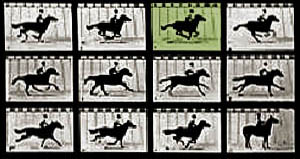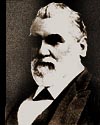|

A ‘Flying Horse’ Carries Muybridge to New Adventures in America
In the 1850s, Muybridge traveled from his home in Kingston-on-Thames,
England to San Francisco. He established himself as an innovative
photographer, specializing in skyline panoramas — the QuickTime VRML of its day.
 In
California, he met the state’s former governor Leland Stanford, a railroad
tycoon and avid horse breeder. Stanford asked Muybridge to settle an
age-old arguement among sportsmen. Did all four hooves of a trotting
horse leave the ground for an instant? Does a fast horse actually ‘fly?’ In
California, he met the state’s former governor Leland Stanford, a railroad
tycoon and avid horse breeder. Stanford asked Muybridge to settle an
age-old arguement among sportsmen. Did all four hooves of a trotting
horse leave the ground for an instant? Does a fast horse actually ‘fly?’
With a $40,000 grant, Muybridge set to work in Sacramento in 1872. He erected
a bank of glass plate cameras triggered by strings and rubber
bands, snapped by the hooves of a celebrated harness racehorse named Occident.
The resulting photo sequence was an international sensation,
launching Muybridge on a European speaking tour and earning him a place
in the history of photography. The Flying Horse project also sparked
the movies’ first lawsuit — a bitter court battle with Stanford over
who should rightfully claim credit.
|
Eureka!
Eadweard
Muybridge had created the technology to create sequential images — and
to project them.
He mounted small glass plates on a circular disc rotated between a calcium
carbide ‘limelight’ and a lens, a device Muybridge called the Zoopraxiscope.
 Astonished audiences saw the illusion of moving images.
Astonished audiences saw the illusion of moving images.
The
action looped repeatedly, just as it does here. It was considered nothing
less than miraculous. It was the birth of motion pictures.
The news media reported . . .
‘Mr. Muybridge
has laid the foundation of a new way of entertaining people and we predict
that his magic lantern will make the round of the civilized world.’
—Alta
California
Palo Alto, California
May 5, 1880
 |


 Astonished audiences saw the illusion of moving images.
Astonished audiences saw the illusion of moving images.